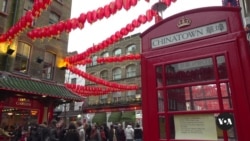ເມືອງ ຈີນ ຂອງນະຄອນຫຼວງ ລອນດອນ ແມ່ນຫົວໃຈທີ່ກຳລັງເຕັ້ນຂອງເຂດບັນເທີງຂອງນະຄອນຫຼວງດັ່ງກ່າວ, ດ້ວຍອາຫານທີ່ມີລົດຊາດພິເສດທີ່ເຊື່ອມໂຍງຢ້ອນກັບຄືນໄປປະຫວັດສາດການເປັນຫົວເມືອງຂຶ້ນຂອງ ອັງກິດ, ເຮັນຣີ
ຣິຈແວລ ມີລາຍ, ເຊິ່ງ ພຸດທະສອນ ຈະນຳເອົາລາຍລະອຽດມາສະເໜີທ່ານ.
ຜູ້ຈັດການຮ້ານອາຫານ ທ່ານ ເຈັຟຟຣີ ລຽງ ແມ່ນຜູ້ທີ່ຫຼົງໄຫຼໃນດິມຊຳ ແລະ ລາວຍັງໄດ້ຖືກຮັບຮອງໂດຍຣາຊະວົງ.
ທ່ານ ລຽງ ໄດ້ເສີບອາຫານດິມຊຳ ແລະ ຊາຈີນ ໃຫ້ກະສັດ ຊາລສ໌ ທີ່ເວລານັ້ນຍັງເປັນເຈົ້າຊາຍຢູ່ ແລະ ພັນລະຍາຂອງເພິ່ນ, ເຈົ້າຍິງ ຄາມີລາ, ຢູ່ຮ້ານອາຫານຂອງລາວໃນເມືອງຈີນ ເມື່ອປີ 2015.
ຊາວຮົງກົງຜູ້ນີ້ໄດ້ເດີນທາງມາຮອດນະຄອນຫຼວງ ລອນດອນ ໃນປີ 1987.
ທ່ານ ເຈັຟຟຣີ ລຽງ, ຜູ້ຈັດການຮ້ານອາຫານກ່າວວ່າ “ໂຕຂ້ອຍເອງ, ໄດ້ມາ. ຂ້ອຍເວົ້າພາສາອັງກິດບໍ່ເປັນຈັກໂຕ.”
ເວລານັ້ນທ່ານ ລຽງ ມີອາຍຸ 10 ປີ.
ທ່ານ ເຈັຟຟຣີ ລຽງ ກ່າວວ່າ “ພໍ່ແມ່ຂອງຂ້ອຍເລືອກທີ່ຈະມາ ລອນດນອນ ເພາະວ່າ, ອີກຄັ້ງ, ກໍເປັນຍ້ອນສາຍພົວພັນທີ່ດີຫຼາຍລະຫວ່າງ ອັງກິດ ແລະ ຮົງກົງ ແລະ ຈີນ ຕະຫຼອດປີທີ່ຜ່ານມານີ້ໄດ້ເຮັດໃຫ້ສາມາດເຂົ້າໃຈເຖິງພາສາ ແລະ ວັດທະນະທຳ. ລອງຈິນຕະນາການເບິ່ງຮ້ານອາຫານແຫ່ງທຳອິດທີ່ເປີດຢູ່ທີ່ນີ້, ເວລາທີ່ເປັນຄອບຄົວທຳອິດທີ່ໄດ້ເປີດມັນ, ແລະ ຄົນ ຈີນ ທຸກຄົນທີ່ໄປຈະເວົ້າວ່າ “ວາວ, ຮ້ານນັ້ນຈັ່ງແມ່ນຄົນຫຼາຍ. ເຮົາເປີດອີກຮ້ານນຶ່ງບໍ,” ການແຂ່ງຂັນຄົງຈະດີຫຼາຍ.”
ເມືອງ ຈີນ ຕັ້ງຢູ່ໃຈກາງຂອງນະຄອນຫຼວງ ລອນດອນ. ຊຸມຊົນ ຈີນ ແມ່ນໄດ້ມາຢູ່ລອນດອນດົນຫຼາຍ, ຖືກດຶງດູດເຂົ້າມາໃນຕົວເມືອງຍ້ອນທ່າເຮືອຂອງເຂົາເຈົ້າ, ກ່າວໂດຍຜູ້ນຳທ່ຽວໃນທ້ອງຖິ່ນ ທ່ານນາງ ເຟຣຢາ ໄອທເຄັນ ທັຟ.
ທ່ານນາງ ເຟຣຢາ ໄອທເຄັນ ທັຟ, ຜູ້ບໍລິຫານໃຫຍ່ບໍລິສັດ China Exchange ກ່າວວ່າ “ໃນທ້າຍຊຸມປີ 1800, ພວກເຮົາເຫັນການຍົກຍ້າຍຖິ່ນຖານຂະໜາດໃຫຍ່ເຂົ້າມາເຂດນຶ່ງຂອງ ລອນດອນທີ່ເອີ້ນວ່າ ໄລມຮາວສ໌. ມັນຢູ່ຟາກຕາເວັນອອກຈາກບ່ອນນີ້, ແລະ ມັນແມ່ນບ່ອນທີ່ທ່າເຮືອ ດັອກແລນສ໌ ຂອງ ລອນດອນ ຕັ້ງຢູ່. ພວກຜູ້ຊາຍທີ່ວ່ານີ້ແມ່ນຖືກເກນມາຮ່ວມເປັນນັກເດີນເຮືອ ເພື່ອເປັນພະນັກງງານໃຫ້ກຳປັ່ນຂົນສົ່ງ.”
ຊຸມຊົນ ຈີນ ໄດ້ເລີ່ມທີ່ຈະຍ້າຍເຂົ້າໄປໃນ ໂຊໂຮ ໃນໃຈກາງນະຄອນຫຼວງ ລອນດອນ ໃນກາງສັດຕະວັດທີ 20, ພ້ອມກັບຊຸມຊົນຜູ້ຍົກຍ້າຍຖິ່ນຖານອື່ນໆ.
ທ່ານນາງ ເຟຣຢາ ກ່າວວ່າ “ຄ່າເຊົ່າຢູ່ທີ່ນີ້ໃນຊຸມປີ 1960 ແມ່ນຂ້ອນຂ້າງຕ່ຳ, ໄລຍະການເຊົ່າແມ່ນສັ້ນ, ແລະ ນັ້ນໄດ້ເຮັດໃຫ້ຄົນມີໂອກາດ ທີ່ຈະສ່ຽງເພື່ອມາ ແລະ ຕັ້ງຖິ່ນຖານຢູ່ທີ່ນີ້.”
ຊຸມຊົນ ຈີນ ແມ່ນມີຄວາມຫຼາກຫຼາຍ, ດ້ວຍການເຊື່ອມໂຍງກັບປະຫວັດສາດການເປັນຫົວເມືອງຂຶ້ນຂອງ ອັງກິດ.
ທ່ານນາງ ເຟຣຢາ ກ່າວວ່າ “ຫຼາຍຄົນຜູ້ທີ່ໄດ້ມາຮອດໃນເຂດນີ້ ແລະ ເລີ່ມຕົ້ນທຸລະກິດຕ່າງໆໃນລະຫວ່າງຊຸມປີ 1960 ໄດ້ຕິດຕາມຄົນ ຈີນ ຈຳນວນນຶ່ງ, ແຕ່ກໍມີເຄືອຈັກກະພົບຈີນດ້ວຍ ເຊັ່ນ ຈີນມາເລເຊຍ, ຈີນສິງກະໂປ, ຈີນທະເລຄາຣິບບຽນ, ຈີນ ກີອານານ. ແລະ ສະນັ້ນ ສະບັບຂອງຄົນ ຈີນນັ້ນ ຕ້ອງມີຄວາມຊັບຊ້ອນທຸກຢ່າງດັ່ງກ່າວນີ້ກັບເຂົາເຈົ້າ. ໃນລະຫວ່າງ ຊຸມປີ 1960 ແລະ 1970, ພວກເຮົາເຫັນຄືນການຍົກຍ້າຍຖິ່ນຖານທີ່ໃຫຍ່ກວ່າຈາກກຸ່ມຄົນທີ່ເວົ້າພາກສາຈີນ ກວາງຕຸ້ງ ຈາກຮົງກົງ ແລະ ເຂດແດນໃໝ່ຕ່າງໆ.”
ສອງສາມທົດສະວັດທີ່ຜ່ານມາ ໄດ້ມີຜູ້ຍົກຍ້າຍຖິ່ນຖານທີ່ເດີນທາງມາຈາກຫຼາຍພາກສ່ວນຂອງ ຈີນ, ຕັ້ງທຸລະກິດຂຶ້ນຢູ່ທີ່ນີ້.
ທ່ານ ເຈັຟຟຣີ ລຽງ ກ່າວວ່າ “ດຽວນີ້ມັນມີອາຫານປະຈຳພາກພື້ນຂອງຈີນຫຼາຍກວ່າເກົ່າ. ພວກເຮົາມີອາຫານຈາກແຂວງ ຊິນຈຽງ ຄືແກະເອືອບຜົງຄູມິນ. ພວກເຮົາມີອາຫານຈາກ ດອງເບ, ເຊິ່ງແມ່ນເສັ້ນທາງເກົ່າຂອງ ຈີນ.”
ເມືອງ ຈີນ ຂອງນະຄອນຫຼວງ ລອນດອນ ແມ່ນຍັງຄົງເປັນບ່ອນທີ່ບໍ່ແມ່ນສຳລັບທີພັກອາໄສ, ແຕ່ເປັນຈຸດໝາຍປາຍທາງສຳລັບຄົນ ຈີນ ແລະ ຊຸມຊົນເອເຊຍອື່ນໆ. ແນວໃດກໍຕາມບາງຄົນເຫັນມັນດັ່ງກັບຕົວແທນຂອງວັດທະນະທຳຂອງເຂົາເຈົ້າ, ອີງຕາມການກ່າວຂອງທ່ານນາງ ເຟຣຢາ.
ທ່ານນາງ ເຟຣຢາ ກ່າວວ່າ “ນີ້ແມ່ນສະຖານທີ່ທຸລະກິດ, ນີ້ແມ່ນບໍ່ທີ່ຄົນມາຊຸມນຸມສັງສັນ. ສຳລັບບາງຄົນທີ່ມີເຊື້ອສາຍເອເຊຍຕາເວັນອອກ ແລະ ຕາເວັນອອກສຽງໃຕ້, ຄວາມຄິດນັ້ນທີ່ວ່າມູນເຊື້ອທາງວັດທະນະທຳຂອງເຂົາເຈົ້າແມ່ນເຊື່ອມຕໍ່ຢ່າງໃກ້ຊິດກັບເຂດນີ້ແມ່ນສາມາດເຮັດໃຫ້ເກີດຄວາມບໍ່ພໍໃຈ, ເຈັບປວດ, ແລະ ເປັນແງ່ລົບ. ສຳລັບຄົນອື່ນໆ, ສະຖານທີ່ນີ້ແມ່ນຄວາມພາກພູມໃຈທີ່ຍິ່ງໃຫຍ່.”
ໃນຂະນະທີ່ຜູ້ຮັບປະທານອາຫານຍັງສາມາດຊອກຫາຊາຈີນພື້ນເມືອງໄດ້ຢູ່ທີ່ນີ້, ຮ້ານຊາໄຂ່ມຸກຫຼາຍຮ້ານໄດ້ຕັ້ງຂຶ້ນຢູ່ທີ່ນີ້ໃນບໍ່ເທົ່າໃດປີທີ່ຜ່ານມາ ເພື່ອເອົາໃຈເພດານປາຂອງຄົນໄວໜຸ່ມ ໃນຂະນະທີ່ເມືອງຈີນຂອງ ນະຄອນຫຼວງ ລອນດອນ ເຕີບໂຕກັບແນວໂນ້ມພາຍໃນ ແລະ ທົ່ວໂລກ. ມັນເປັນສະຖານທີ່ແຫ່ງປະຫວັດສາດ ທີ່ບໍ່ເຄີຍຢືນຢູ່ລ້າໆ.
ອ່ານລາຍງານນີ້ເປັນພາສາອັງກິດ
Restaurateur Geoffrey Leong is a dumpling fanatic – and his even have royal approval.
Leong served dim sum and Chinese tea to then-Prince Charles and his wife, Camilla, at his Chinatown restaurant in 2015.
This Hong Kong native arrived in London in 1987.
“I, myself, came over. I couldn’t speak a word of English.”
Leong was 10 years old.
“My parents chose for us to come to London because, again, the really good relationship between Britain and Hong Kong and China throughout these years has enabled the understanding of the language, the culture. Imagine the first restaurant that opened here, when the first family that opened, and all the Chinese goes, 'Wow, that restaurant is busy. Let’s open another one.' Competition has to be healthy.”
Chinatown lies at the very heart of the British capital. Chinese communities have long been in London – drawn to the city because of its port, says local guide Freya Aitken-Turff.
“In the late 1800s, we see a large-scale migration into an area of London called Limehouse. It's east of here, and it's where London’s Docklands are. These gentlemen were recruited as sailors to staff the shipping fleets.”
Chinese communities began to move into Soho in central London in the mid twentieth century – alongside other migrant communities.
“Rents here in the 1960s were relatively low, leases were short, and that gave people the chance or the opportunity to take the risk to come and settle here.”
The Chinese community is diverse – with links to Britain’s colonial history.
“Many of those people arriving into this area and starting businesses during the 1960s follow some of those Chinese, but also Chinese Commonwealth roots - Malaysian Chinese, Singaporean Chinese, Caribbean Chinese, Guianan Chinese. And so that version of ‘Chineseness’ needs to have all of this complexity reflected within it. During the 60s and 70s, we see a larger wave of migration from culturally Cantonese-speaking groups of people from Hong Kong and the New Territories.”
Recent decades have seen immigrants arriving from different parts of China, setting up business here.
“There's now a lot more regional Chinese food. We have dishes from Xinjiang – (like) lamb with cumin. We've got dishes from Dongbei, which is the old rust belt of China.”
London’s Chinatown has remained not as a place of residence, but as a bustling destination for Chinese and other Asian communities - although some see it as a clichéd representation of their culture, says Aitken-Turff.
“This is a place of business, this is place where people come to socialize. // For some people of East and Southeast Asian heritage, that idea that their cultural heritage is so closely connected to this area can be offensive, painful, not positive. For others, this a place of great pride.”
While diners can still find traditional Chinese tea here, many bubble tea shops have popped up in recent years to satisfy younger palates — as London’s Chinatown evolves with local and global trends. A place of history – that never stands still.







ຟໍຣັມສະແດງຄວາມຄິດເຫັນ